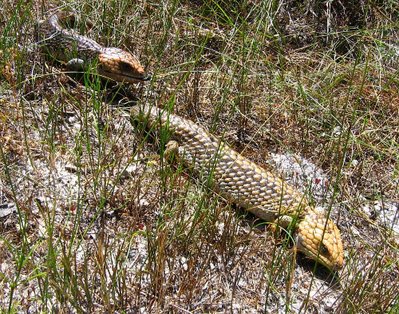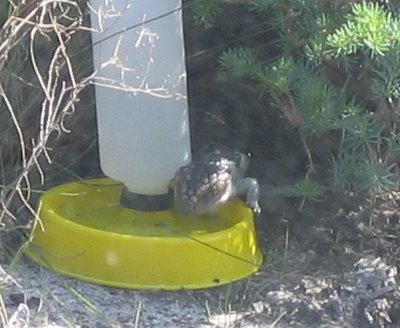Also known as the Shingleback, Bobtail, Sleepy Lizard, Pinecone Lizard and the Boggi.
They occur in the drier regions of five States and do remarkably well in built-up areas, living under houses, in pipes, under vegetation, rocks or logs. They are omnivores and happily eat snails, slugs and caterpillars, they also consume a large selection (more than most reptiles) of vegetation, flowers and fruits. Although you might not want a Stumpy-tail in your strawberry patch, they are otherwise excellent for keeping many plant-eating pests under control.
These lizards are a dentist's delight. If you say open wide, the head almost separates in two, showing strong muscles and a broad fleshy purple/blue tongue. The males although slightly smaller than the females (can grow to over 40 cm in length) have the larger head and during the breeding season can be very aggressive to other males.

These lizards are usually solitary, but do not avoid others and often meet up during the year. However, they sort themselves into couples at the approach of the mating season (September to November). Initially they just go about together, but closer to the time of mating, the male follows the female around for a couple of weeks and lookout any unattached male in their vicinity, as they are chased off very smartly, however other roving couples are not met with the same aggression. This may be because they only have one partner per season, although the same pair may get together for several years. One couple has been recorded in a ten year relationship, the longest known for any reptile. From two to six young are born live, five months after mating and are independent from birth, although strangely, close family members can apparently recognise each other even after long separation.

Stumpy-tailed Lizards can live without water for extended periods, but appreciate a drink when available.

Despite their large size and somewhat clumsy appearance, they can be a very attractive lizard, with large soft eyes that can wink at you with their moveable lower eye-lid.

They are often found within low flowering plants, no doubt sampling the produce.

Predation from native species are largely restricted to juvenile animals and tend to be from birds like kookaburras, birds of prey and large snakes. However most are preyed upon, or simply killed by cats, foxes and dogs, plus a heavy toll is taken on the roads as they slowly cross or sun-bake.
From the perspective of the lizard's prey, at this level they can look like a very big snake.


8 comments:
Test
...These lizards are a dentist's delight. If you say open wide, the head almost separates in two, showing strong mussels and a broad fleshy purple/blue tongue...
LOL
At the risk of sounding sycophantic, yet another compliment coming your way - but there just isn't any fault I can find with your blog:
I like the way you "tell a story", excellent for people who want to learn but have a short attention-span like myself...and what a thought-provoking denouement of this story, from the prey's perspective...: speaking of "prey", do they bite us humans, when disturbed?
>>speaking of "prey", do they bite us humans, when disturbed?<<
Hi MissAnthropy, I'm pleased you are still enjoying the blog, I can't imagine anyone not liking nature, although I know there must be some.
Re your query above, they can and will bite people if they get the chance, but fortunately being rather slow, seldom have the opportunity. They do however have very strong jaws and can crunch happily on garden snails (including their shells), so young children should be careful and not provoke them.
Happy reading to you. :)
Jack
unless it's a typo, which my browser detects and points out, mussels is spelled muscles.
Thanks VFD.
I wanna come play in your yard
-NLChris
Hi Chris, sorry, you will have to make do with your local National Park. :)
I used to collect reptiles when I was a kid and had many Shinglebacks. I found them an extraordinary lizard, curious, seemingly of significant intelligence when compared against Bluetongues, Water Dragons, Bearded Dragons, etc.
One used to follow my mother around our large back garden as she tended to it. I used to take it to school, under strict supervision, and show the other boys how I could get him to open his gaping jaws and put my finger in his mouth without fear of him biting me.
Then came my teen years and rock music. I started what was to become the band Australian Crawl and encountered crawling creatures significanly less trustworthy. All the reptiles were released into the specific relevant natural environment.
Post a Comment